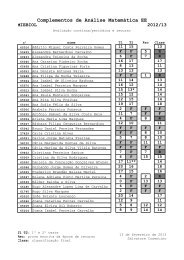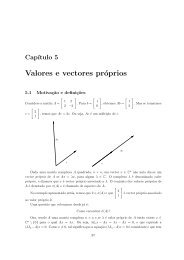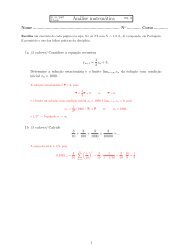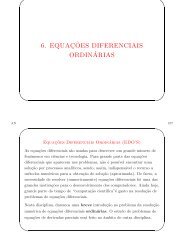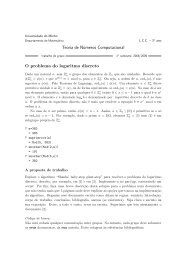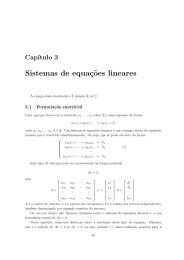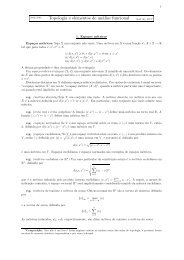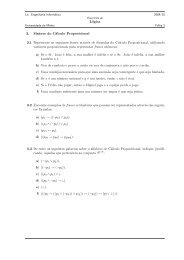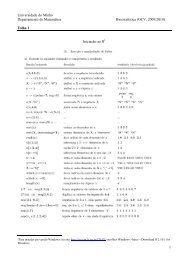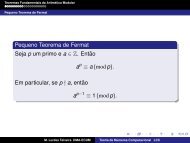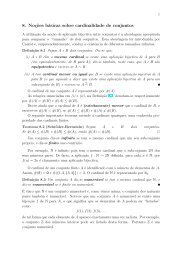My title - Departamento de Matemática da Universidade do Minho
My title - Departamento de Matemática da Universidade do Minho
My title - Departamento de Matemática da Universidade do Minho
Create successful ePaper yourself
Turn your PDF publications into a flip-book with our unique Google optimized e-Paper software.
7 OSCILLATIONS AND CYCLES 53<br />
Phase portrait of a mathematical pendulum (without and with friction)<br />
Jacobi elliptic functions. What <strong>do</strong>es a mathematician/physicist <strong>do</strong> when he/she face an integral<br />
and <strong>do</strong>esn’t see how to solve it in terms of known functions He/she gives a name to<br />
it.<br />
√<br />
E+1<br />
Define k =<br />
2<br />
and then x = 1 k<br />
sin(θ/2). The conservation of energy reads<br />
ẋ = √ (1 − x 2 )(1 − k 2 x 2 )<br />
There follows that time is given by the so called Jacobi’s elliptic integral of the first kind<br />
∫<br />
dx<br />
t = √<br />
(1 − x2 )(1 − k 2 x 2 )<br />
The solution, actually the inverse function x = sn(t, k) as a function of t and the parameter k, is<br />
“named” Jacobi elliptic function.<br />
Tis is the beginning of along story. You may want to know that sn, as well its relatives, is a<br />
quotient of products of Jacobi’s theta functions, hence, we are at the intersection between complex<br />
analysis, algebraic geometry, number theory, ...<br />
7.3 Central forces and planetary motions<br />
Bertrand theorem. 17 The unique central forces F (r) such that any boun<strong>de</strong>d orbit is periodic<br />
are the Newtonian force F (r) = k/r 2 and the elastic force F (r) = kr.<br />
Two-body problem. Kepler problem <strong>de</strong>als with the motion of two point-like bodies (planets<br />
and/or stars) un<strong>de</strong>r mutual gravitational interaction. Let m 1 , m 2 > 0 be their masses, and q 1 , q 2 ∈<br />
R 3 their positions, respectively. Gravitational interaction is <strong>de</strong>scribed by the conservative force<br />
−∇V with potential energy<br />
V (q 1 , q 2 ) = G m 1m 2<br />
|q 1 − q 2 |<br />
where G is the gravitational constant. This force verifies the ”third law of dynamics”, hence the<br />
total linear and angular momentum<br />
and<br />
P = m 1 ˙q 1 + m 2 ˙q 2 M = m 1 q 1 ∧ ˙q 1 + m 2 q 2 ∧ ˙q 2<br />
are conserved. This implies that the center of mass moves at uniform rectilinear speed and that<br />
the motion of the two bodies takes place in a plane orthogonal to the angular momentum M. If<br />
we choose a Galileian reference system where P = 0 and M is parallel to the z-axis (in particular<br />
M is supposed different from the zero vector, a case which leads to a collision ...) , the full system<br />
is <strong>de</strong>scribed by the single vector q 2 − q 1 in the x-y plane, which we write in polar coordinates<br />
as ρe i2πθ . It turns out that the two-body problem is equivalent to the motion of a single point<br />
mass m = m1m2<br />
m 1+m 2<br />
moving on a plane un<strong>de</strong>r the influence of a potential energy V (ρ) = −G m ρ , the<br />
(conserved) energy beeing<br />
E = 1 2 m (<br />
˙ρ 2 + ρ 2 ˙θ2 ) + V (ρ)<br />
17 J. Bertrand, Théorème relatif au mouvement d’un point attiré vers un centre fixe, C. R. Acad. Sci. 77 (1873),<br />
849-853.



